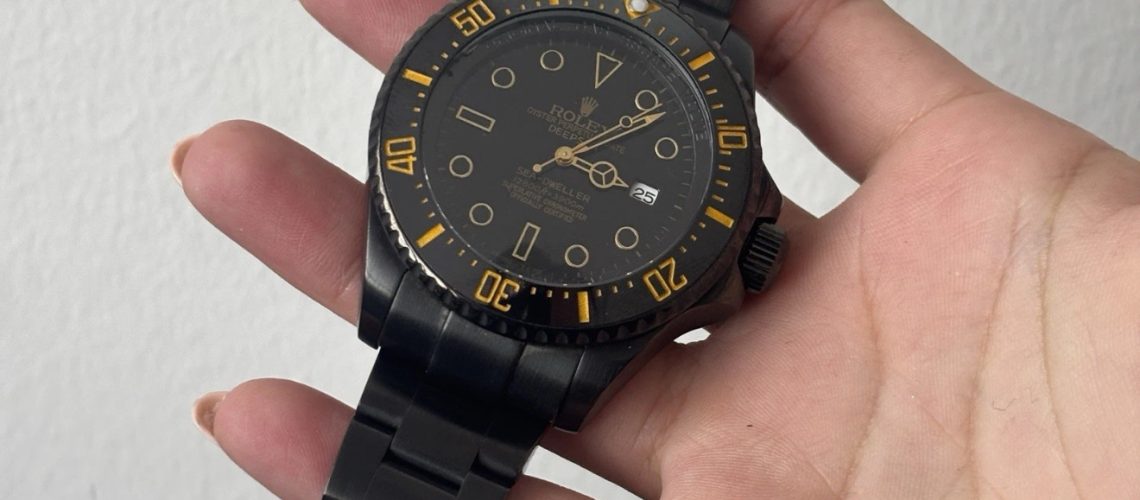Introduction
The modern collector isn’t hunting for another watch. He’s building identity. That’s why PVD-coated and custom-modified watches have exploded across the market. Blacked-out Rolexes, tactical Seamasters, and full-stealth Tudors dominate Instagram feeds and draw in younger collectors ready for something different.
But customization comes with consequences. Some mods elevate a watch. Others destroy value, void warranties, or hide underlying issues. At Tailored Timepieces, we see thousands of watches a year—factory, vintage, aftermarket, and everything in between—so we’ve seen both the art and the disasters firsthand.
This guide breaks down all of it: the good, the bad, and the ugly of PVD and custom watches, grounded in widely-accepted industry knowledge.
What PVD Actually Is
PVD (Physical Vapor Deposition) is a process that bonds a thin, hardened coating onto a watch’s steel surface. Brands have used variations of this coating technology for years on select factory models. The result: a modern, tactical finish with increased surface resistance.
It offers:
- A harder surface layer than raw stainless steel
- Strong wear resistance within normal use
- Stealth black, gunmetal, bronze, gold, and other color options
- A legitimate coating technology used in multiple industries
Aftermarket PVD isn’t inherently bad—but execution varies wildly.
Why PVD and Custom Watches Are Surging
Individuality
Collectors don’t want the same Submariner everyone else has.
Social media aesthetics
A murdered-out case photographs better than brushed steel.
Microbrand influence
Independents normalized creative finishes, shifting collector expectations.
Reconditioning
Heavily worn cases can look new with a full refinish plus PVD.
Style alignment
Collectors want watches that match how they dress and how they move.
THE GOOD
1. A dominant aesthetic
Clean lines, modern attitude, and a finish that commands attention.
2. Upgraded surface toughness
PVD coatings typically outperform untreated steel in surface wear resistance.
3. Cost-effective transformation
Instead of paying for rare factory variants, collectors get a unique look at accessible pricing.
4. Freedom to wear hard
Collectors tend to feel more comfortable wearing modded pieces without worrying about collector-grade originality.
5. Unlimited creative options
Blackout, gold, green, frosted, two-tone—even full colorways manufacturers never attempt.
THE BAD
1. Lower resale value
Modified pieces appeal to a much smaller market.
If resale matters, originality wins every time.
2. Warranty loss
Most manufacturers will not service aftermarket-coated pieces.
Coating removal for service is expensive.
3. Wear reveals bright steel
High-friction areas can show wear over time.
4. Coatings can conceal issues
Some sellers use PVD to hide:
- Over-polishing
- Corrosion
- Aftermarket parts
Transparency becomes critical.
5. Inconsistent workmanship
Inferior prep leads to:
- Uneven color
- Early chipping
- Surface inconsistencies
Fixing poor PVD often requires stripping and recoating the entire watch.
THE UGLY
1. Purist vs. customizer war
Some collectors see mods as creativity.
Others see them as destroying the watch’s identity.
2. Harder authentication
Coating can obscure bevels, lugs, finishing, and metal integrity.
3. Misleading listings
Ambiguous terms like “custom black Rolex” or “DLC style” mislead buyers without documentation.
Is a PVD or Custom Watch Right for You?
It IS for you if:
- You want something visually unique
- You plan to keep the watch long-term
- You don’t rely on factory warranties
- You value style over investment
It is NOT for you if:
- You care about strong resale
- You want historical integrity
- You buy as an investment
- You expect manufacturer service
How To Buy Smart (Tailored Timepieces Checklist)
1. Request before-and-after photos
Confirms condition and originality.
2. Buy only from reputable modders
Good coating requires proper disassembly and prep.
3. Demand full disclosure
Aftermarket PVD, parts changes, refinishing—everything.
4. Plan for future service
Coating removal can add cost later.
5. Choose quality over hype
A poorly executed mod is worse than no mod.
Q&A: Everything Collectors Ask About PVD and Custom Watches
Q: Does PVD make a watch scratch-proof?
No. PVD increases surface hardness, but no coating makes a watch scratch-proof. Normal wear is fine, but sharp impacts can still damage the coating.
Q: Does PVD lower the value of a watch?
Generally, yes. Aftermarket mods reduce the buyer pool. Factory-original watches almost always maintain stronger value.
Q: Can manufacturers service a PVD-coated watch?
Typically no. Most brands will refuse service or require stripping the coating. Aftermarket-coated pieces often need independent watchmakers.
Q: Can PVD hide case damage?
Yes. Coating can mask over-polished surfaces or corrosion. This is why transparency from the seller is critical.
Q: Will the PVD eventually wear off?
High-friction areas can show wear over time. The coating itself is durable, but not permanent.
Q: Should I buy a modded Rolex?
If you love the look and plan to wear it, yes. If you care about long-term value or collectibility, no.
Q: Can I reverse a PVD coating?
Technically yes, but it requires specialized stripping and refinishing. It’s not inexpensive, and results vary.
Q: Are custom watches bad investments?
They are not “investments” in the traditional collector sense. They are personal pieces designed for expression, not resale.
Q: Does Tailored Timepieces sell custom watches?
Yes, selectively—and with full transparency. Every modded piece we sell is clearly disclosed and inspected internally before listing.
Conclusion
PVD and custom watches sit in their own lane—creative, bold, and unique. They offer individuality that factory models rarely match. But they also come with tradeoffs: lower resale value, warranty limitations, and potential for hidden issues if sourced from the wrong seller.
Know why you’re buying the watch.
Know who performed the work.
Know the long-term implications.
A custom watch can be your signature piece—when chosen with clarity and intention.

